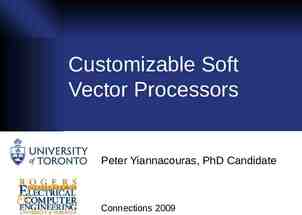CSP Program Summit 2016 Sodium Ion Expansion Power Block
15 Slides2.25 MB
CSP Program Summit 2016 Sodium Ion Expansion Power Block for Distributed CSP energy.gov/sunshot CSP Program Summit 2016 energy.gov/sunshot Shekar Balagopal, Program P.I. Ceramatec, Inc. Prof. Shannon Yee, Co. P.I. Georgia Institute of Technology
Program Objectives Develop a modular heat engine power block with an estimated efficiency (ηte) of 51.3%. Program Goals: Integrate ion-conducting electrochemical conversion materials into a heat engine Establish ceramic manufacturing techniques to achieve record low membrane thicknesses Apply 3D porous electrodes to minimize over potential losses Develop evaporation and drop-wise condensation to realize high thermal efficiencies Develop thermal-electric conversion system with design, modeling, and component testing Assemble and demonstrate a 50% heat-toelectric power efficient breadboard validation in using a 70 We module, with design scalable to a 1 kWe CSP Program Summit 2016 energy.gov/sunshot 22
A Single Stage Sodium ThermoElectro-Chemical Converter (NaTECC) Process modeled thermodynamically as isothermal expansion. Temperature entropy diagram represents the ideal reversible cycle for a single stage CSP Program Summit 2016 energy.gov/sunshot Thermodynamic operation of a singlestage device. Sodium is in liquid state. Liquid sodium is heated in evaporator, vaporizes and travels to anode. Oxidation occurs at anode, and pressure gradient between hot cold side drives cations through the solidelectrolyte. Electrons travel through load where power is extracted, and recombines with sodium and converts to liquid at condenser with heat rejection. Sodium is cooled and condenses evaporator using a wick. Loop is closed via a capillary wick returning liquid sodium to evaporator. 33
What are the Advantages of a Na-TECC? 1. 2. 3. 4. 5. High second law efficiency ( 90% of the Carnot limit) High specific power (up to 0.2 kW/kg) Closed system operation with no moving parts Scalable to multiple power levels (100 W -10 kW) Amenable to cogeneration using rejected heat Fraction of Carnot Efficiency 1 0.98 0.96 Th 800 0.94 Th 900 Th 1000 0.92 Th 1200 0.9 CSP Program Summit 2016 energy.gov/sunshot Th 1100 600 800 Tc (K) 1000 1200 44
Improving the Efficiency by Using Multiple-Stages The efficiency of a multiple-stages engine is: Z 1 Z 1 i i 1 Thot Staging is beneficial for the Na-TECC: 1 W1 2 W2 Z WZ Tcold CSP Program Summit 2016 energy.gov/sunshot The thermal stress across the BASE is reduced – less crack propagation – lower loss of NaO2 – improved lifetime Improved thermal management – Lower parasitic heat losses The Regeneration and Reheating steps allow the engine to reach lower temperatures 55
Dual Stage Process With dual stage cycle, the first expansion reaches an intermediate pressure and heat is regenerated for the second expansion from the isobaric cooling. We can extract additional power through a reheat step. This allows us to go to a lower temperature than with the single stage, using the same heat input ηdual 52.3% With regeneration, the dual stage is thermodynamically favorable CSP Program Summit 2016 energy.gov/sunshot 6
Voltage and Efficiency of a Single Stage Na-TECC 1 0.9 0.8 0.7 0.6 0 Open Circuit B Overpotential RTh 0.5 (cm2) 0.05 0.1 0.15 0.2 2 Current Density [A/ cm ] Thot 1150 K Tcold 550 K 0.25 45 Efficiency % Cumulative Voltage Drop Voltage [V] 1.1 Cumulative Efficiency Drop 50 40 35 30 Open Circuit B Overpotential RTh 0.5 (cm2) Qloss 40% 25 20 0 0.1 0.2 0.3 0.4 2 Power Density [kW/ m ] 0.5 The largest efficiency drop is caused by parasitic heat loss ( 40%) Vopen 1.09 CSP Program Summit 2016 energy.gov/sunshot 77
Voltage and Efficiency of a Dual Stage Na-TECC 1.2 0.8 0.6 0.4 0.2 0 0 Open Circuit B Overpotential RTh 0.5 (cm2) 0.05 0.1 0.15 0.2 2 Current Density [A/ cm ] Thot 1150 K Tint 800 K Tcold 462.5 K Vopen 1.173 CSP Program Summit 2016 energy.gov/sunshot 0.25 Cumulative Efficiency Drop Voltage 1 Efficiency % Cumulative Voltage Drop 50 40 30 Open Circuit B Overpotential 20 RTh 0.5 (cm2) Qloss 10% 10 0 0.1 0.2 0.3 0.4 2 Power Density [kW/ m ] 0.5 The largest efficiency drops are now caused by concentration losses and Joule heating 8 8
Challenges with the Dual Stage Operation Challenges The dual stage has higher pressure losses, more Joule heating losses, and a larger overpotential than the single stage The dual stage requires larger electrolyte area for the same power However, the dual stage can have lower thermal losses than a single stage and thus better thermal management and higher efficiency Temperature Profiles Illustration: Single Stage Dual Stage By adding a second stage, the hot and cold sides can be better thermally isolated from another CSP Program Summit 2016 energy.gov/sunshot 9
Power Conversion Beta-Alumina (Na2O-11Al2O3) is the Solid Electrolyte (BASE) Mobile cation is sodium Interstitial transport of cations through the conduction plane Anode Cathode Solid-Electrolyte e- e- Na Na 3 Na 4 Na 1 Na Na 2 Na CSP Program Summit 2016 energy.gov/sunshot 1. 2. 3. 4. Charge Transfer Surface diffusion Desorption Diffusion 10 10
Electrochemical Performance PROPERTIES Tensile strength Ionic Conductivity Chemical Stability to Na expected CSP Program Summit 2016 energy.gov/sunshot BASE for HT stage NaSelect for LT @ 1200 K stage @ 850 K 300 Mpa 80 Mpa 400 mS/cm 200 mS/cm 0.5 mg/cm2/hr. 0.5 mg/cm2/hr. Solid Na Ion conducing Electrolytes 11 11
Key Project Milestones Program 36 months: Budget: 2.34 M Contract # DE-EE0007110 CSP Program Summit 2016 energy.gov/sunshot 12 12
Path to Market This power block can be deployed for both: (i) small scale dish solar (displacing dish Stirling) and (ii) large scale heliostats and parabolic trough CSP. Residential power modules is a high growth market to make high value electricity from consolidated solar energy at electricity cost Target: 6 cents/kWhr depending on the region at an estimated cost of 950 for kWe unit Production sizes both (i) large volume production of several smaller distributed modules and (ii) a small number of large centralized power CSP Program Summit 2016 energy.gov/sunshot blocks can be realized with this technology 13
Summary & Conclusions Summary: Discussed operation principles of dual stage Na-TECC The cathode overpotential and concentration losses significantly reduce the voltage and efficiency Introduced staging concept to improve efficiency Conclusions: Regeneration and Reheating can be used in a dual stage Na-TECC to improve the efficiency Dual stage can ultimately achieve higher efficiency due to better thermal management and heat utilizations. Acknowledgement: Dr. Avi Shultz- Program Manager DOE-SunShot Dr. Tom Hinklin, Marc Flinders, Joshua Johnston, Liz Smith Dr. Andrey Gunawan, Alexander Limia, Jong Ha, John Kearns, Dr. Peter Kottke, Prof. Andrei Fedorov, and Prof. Seung Woo Lee CSP Program Summit 2016 energy.gov/sunshot 14 14
CSP Program Summit 2016 Sodium Ion Expansion Power Block for Distributed CSP energy.gov/sunshot CSP Program Summit 2016 energy.gov/sunshot Shekar Balagopal, Program P.I. Ceramatec, Inc. Dr. Shannon Yee, Co. P.I. Georgia Institute of Technology




















